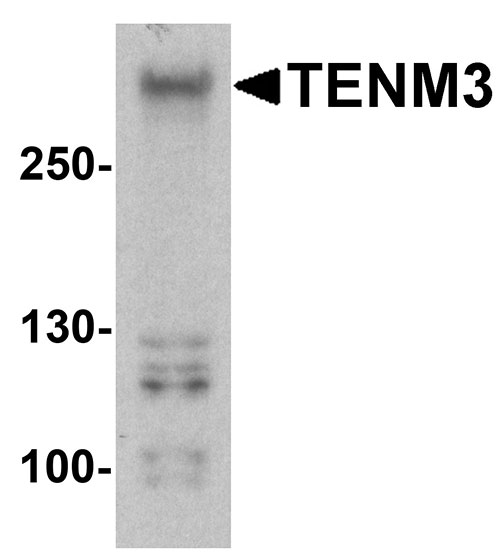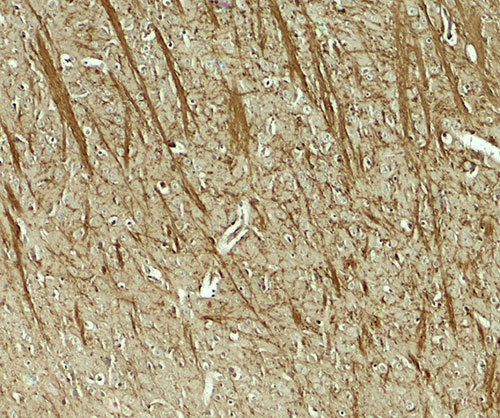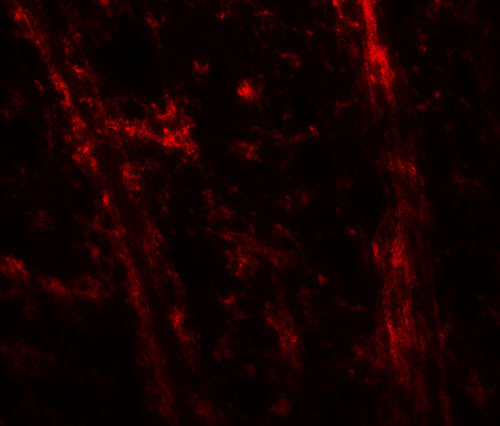TENM3 Antibody
- 产品详情
- 实验流程
- 背景知识
Application
| WB, IF, E, IHC-P |
|---|---|
| Primary Accession | Q9P273 |
| Other Accession | NP_001073946, 122937400 |
| Reactivity | Human, Mouse, Rat |
| Host | Rabbit |
| Clonality | Polyclonal |
| Isotype | IgG |
| Calculated MW | 300950 Da |
| Concentration (mg/ml) | 1 mg/mL |
| Conjugate | Unconjugated |
| Application Notes | TENM3 antibody can be used for detection of TENM3 by Western blot at 1 - 2 µg/mL. Antibody can also be used for immunohistochemistry starting at 5 µg/mL. For immunofluorescence start at 20 µg/mL. |
| Gene ID | 55714 |
|---|---|
| Other Names | Teneurin-3, Ten-3, Protein Odd Oz/ten-m homolog 3, Tenascin-M3, Ten-m3, Teneurin transmembrane protein 3, TENM3, KIAA1455, ODZ3, TNM3 |
| Target/Specificity | TENM3; TENM3 antibody is human, mouse and rat reactive. TENM3 antibody is predicted to not cross-react with other members of the TENM family. |
| Reconstitution & Storage | TENM3 antibody can be stored at 4℃ for three months and -20℃, stable for up to one year. |
| Precautions | TENM3 Antibody is for research use only and not for use in diagnostic or therapeutic procedures. |
| Name | TENM3 (HGNC:29944) |
|---|---|
| Function | Involved in neural development by regulating the establishment of proper connectivity within the nervous system. Acts in both pre- and postsynaptic neurons in the hippocampus to control the assembly of a precise topographic projection: required in both CA1 and subicular neurons for the precise targeting of proximal CA1 axons to distal subiculum, probably by promoting homophilic cell adhesion. Required for proper dendrite morphogenesis and axon targeting in the vertebrate visual system, thereby playing a key role in the development of the visual pathway. Regulates the formation in ipsilateral retinal mapping to both the dorsal lateral geniculate nucleus (dLGN) and the superior colliculus (SC). May also be involved in the differentiation of the fibroblast-like cells in the superficial layer of mandibular condylar cartilage into chondrocytes. |
| Cellular Location | Cell membrane {ECO:0000250|UniProtKB:Q9WTS6}; Single-pass membrane protein {ECO:0000250|UniProtKB:Q9WTS6}. Cell projection, axon {ECO:0000250|UniProtKB:Q9WTS6} |
| Tissue Location | Expressed in adult and fetal brain, slightly lower levels in testis and ovary, and intermediate levels in all other peripheral tissues examined. Not expressed in spleen or liver Expression was high in brain, with highest levels in amygdala and caudate nucleus, followed by thalamus and subthalamic nucleus |
For Research Use Only. Not For Use In Diagnostic Procedures.
Provided below are standard protocols that you may find useful for product applications.
BACKGROUND
The teneurin transmembrane protein 3 (TENM3) is a member of a family of four neuronal cell surface proteins homologous to the Drosophila pair-rule gene Ten-m (1,2). TENM3 is expressed in cartilaginous cells during postnatal growth in mice (3), as well as the adult eye and optic stalk (4). Homozygous null mutations in TENM3 causes microphthalmia in humans (5).
REFERENCES
Ben-Zur T and Wides R. Mapping homologs of Drosophila odd oz (odz): Doc4/Odz to mouse chromosome 7, Odz1 to mouse chromosome 11; and ODZ3 to human chromosome Xq25. Genomics 1999; 58:102-3.
Rubin BP, Tucker RP, Martin D, et al. Tenurins: a novel family of neuronal cell surface proteins in vertebrates, homologous to the Drosophila pair-rule gene Ten-m. Dev. Biol. 1999; 216:195-209.
Murakami T, Fukunaga T, Takeshita N, et al. Expression of Ten-m/Odz3 in the fibrous layer of madibular condylar cartilage during postnatal growth in mice. J. Anat. 2010; 217:236-44.
Ben-Zur T, Feige E, Motro B, et al. The mammalian Odz gene family: homologs of a Drosophila pair-rule gene with expression implying distinct yet overlapping developmental roles. Dev. Biol. 2000; 217:107-20.
终于等到您。ABCEPTA(百远生物)抗体产品。
点击下方“我要评价 ”按钮提交您的反馈信息,您的反馈和评价是我们最宝贵的财富之一,
我们将在1-3个工作日内处理您的反馈信息。
如有疑问,联系:0512-88856768 tech-china@abcepta.com.























 癌症的基本特征包括细胞增殖、血管生成、迁移、凋亡逃避机制和细胞永生等。找到癌症发生过程中这些通路的关键标记物和对应的抗体用于检测至关重要。
癌症的基本特征包括细胞增殖、血管生成、迁移、凋亡逃避机制和细胞永生等。找到癌症发生过程中这些通路的关键标记物和对应的抗体用于检测至关重要。 为您推荐一个泛素化位点预测神器——泛素化分析工具,可以为您的蛋白的泛素化位点作出预测和评分。
为您推荐一个泛素化位点预测神器——泛素化分析工具,可以为您的蛋白的泛素化位点作出预测和评分。 细胞自噬受体图形绘图工具为你的蛋白的细胞受体结合位点作出预测和评分,识别结合到自噬通路中的蛋白是非常重要的,便于让我们理解自噬在正常生理、病理过程中的作用,如发育、细胞分化、神经退化性疾病、压力条件下、感染和癌症。
细胞自噬受体图形绘图工具为你的蛋白的细胞受体结合位点作出预测和评分,识别结合到自噬通路中的蛋白是非常重要的,便于让我们理解自噬在正常生理、病理过程中的作用,如发育、细胞分化、神经退化性疾病、压力条件下、感染和癌症。








